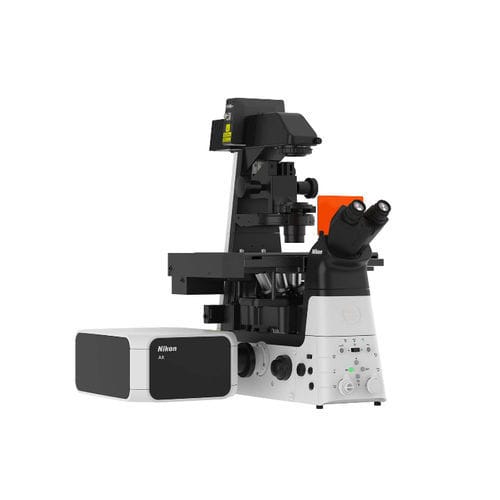
- Laboratory
- Laboratory medicine
- Optical microscope
- Nikon Instruments

- Products
- Catalogs
- News & Trends
- Exhibitions
Optical microscope AXlaboratoryuprightinverted
Add to favorites
Compare this product
Characteristics
- Type
- optical
- Applications
- laboratory
- Ergonomics
- upright, inverted
- Microscope head
- binocular
- Observation technique
- confocal
- Configuration
- benchtop
- Light source
- laser
- Resolution
Max.: 785 nm
Min.: 405 nm
Description
Confocal microscopes have been commercially available now for over 25 years. How can newer iterations of a fundamentally simple instrument continue to innovate? What changes can redefine how a confocal is used, and what data can be collected? Introducing the Nikon AX/AX R Confocal Microscope System, our 10th generation point scanning confocal, giving you more of everything: Leveraging Artificial Intelligence (AI), expanding the number of colors, improving pixel density, sensitivity and speed.
These are significant additions in terms of expanding the range of experiments possible with a point scanning confocal, while increasing the usability and functionality of the instrument, all in a modular and upgradable platform.
Key Features
With the largest field-of-view on both inverted and upright microscope stands available (25mm diagonal), more specimens fit in one FOV with more objective lens choices than ever before.
Coupled with scanning sizes up to 8192 x 8192 pixels, sampling beyond the optical diffraction limit is possible even at low magnifications with the AX/AX R.
Using lower magnifications with longer working distances and high numerical apertures enables more flexible specimen preparations to be used, while the large FOV allows simultaneous high resolution in one image. Collect more data in every image, and at faster rates.
Observe with Minimal Disturbance
Laser scanning confocal imaging is principally challenging on specimen viability, as it applies focused laser illumination point by point on a sample.
Catalogs
MiBrochure
2 Pages
Other Nikon Instruments products
Confocal and Multiphoton Microscopes
Related Searches
- Analysis software
- Microscopy
- Compound microscope
- Laboratory microscope
- Tabletop microscope
- Microscope with LED light
- Viewer software
- Tablet PC software
- Control software
- Laboratory software
- CMOS camera
- USB camera
- LED illuminator
- Digital microscope
- Scan software
- Biological microscope
- Education software
- Microscopy camera
- Binocular microscope
- High-definition camera
*Prices are pre-tax. They exclude delivery charges and customs duties and do not include additional charges for installation or activation options. Prices are indicative only and may vary by country, with changes to the cost of raw materials and exchange rates.


